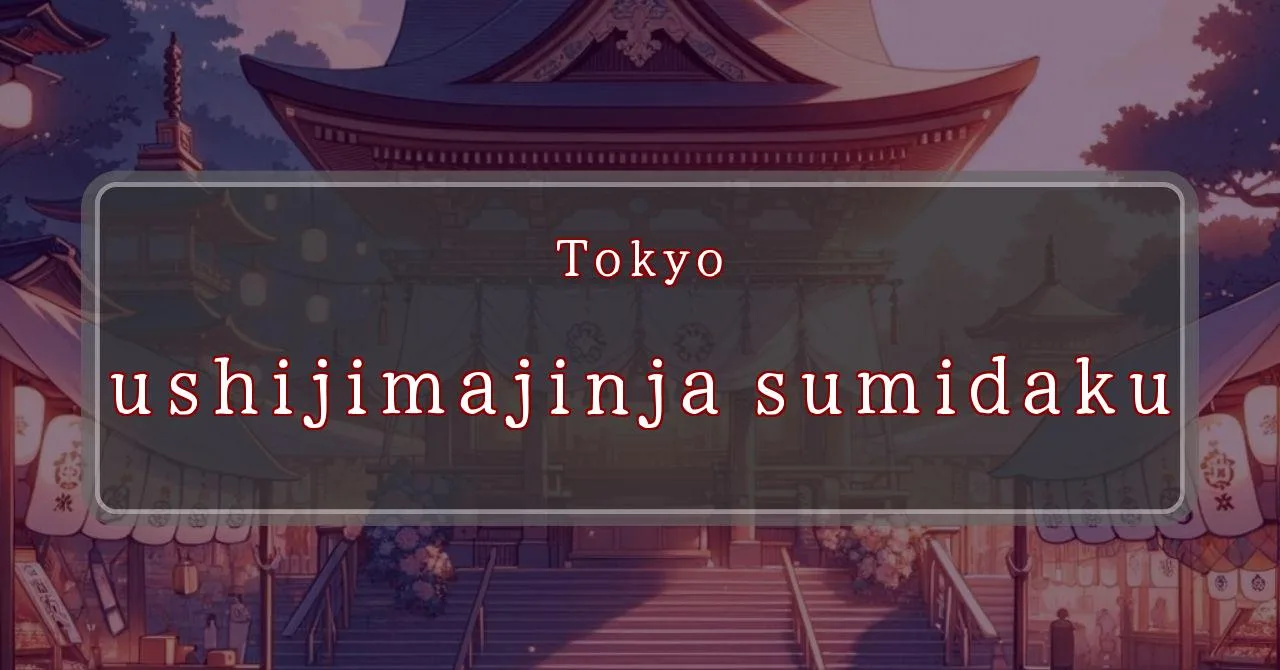Neon-bright lanterns illuminate the night at Sumida’s grand festival
Basic Information
Sumida’s grand festival, held at Ushijima Shrine, is a spectacle of vibrant colors and lively traditions.
- Address: 1-4-5 Mukojima, Sumida-ku, Tokyo
- Phone Number: 03-3622-0973
- Access: A short walk from either Honjo-Azumabashi Station on the Toei Asakusa Line or Tobu Skytree Line’s Tobu Skytree Station
- Festival Days: September 15th (Sun), 2024
Main Events and Attractions of the Festival
The Ushijima Shrine Festival, held annually in Sumida, Tokyo, offers a vibrant display of traditional Japanese culture and festivities.
Mikoshi Procession
One of the main highlights of the festival is the Mikoshi Procession, where portable shrines called mikoshi are carried through the streets by teams of people. These mikoshi are elaborately decorated and believed to house the spirits of the enshrined deities. The procession is a lively and colorful spectacle, with participants chanting and beating drums as they make their way through the neighborhood.
Kagura Performance
Another popular attraction is the Kagura Performance, a traditional form of Japanese dance and music. Kagura is performed by shrine maidens and priests, who wear colorful costumes and enact stories from Japanese mythology. The performances are both visually stunning and spiritually significant, offering a glimpse into Japan’s rich cultural heritage.
Food Stalls
No Japanese festival is complete without food stalls, and the Ushijima Shrine Festival is no exception. Visitors can indulge in a variety of delicious treats, from classic festival fare like yakisoba (fried noodles) and takoyaki (octopus balls) to local specialties and sweets. The food stalls are a great place to sample some of Japan’s culinary delights and soak up the festive atmosphere.
Bon Odori Dance
In the evenings, the festival grounds come alive with the Bon Odori Dance, a traditional Japanese folk dance. Participants of all ages gather in a circle and perform the Bon Odori, a simple yet graceful dance that is said to honor the spirits of the deceased. The Bon Odori is a lively and inclusive event, and visitors are encouraged to join in and experience this unique cultural tradition.
Blessings and Deities
Ushijima Shrine is dedicated to three deities: Susanoo-no-Mikoto, the god of storms and the sea; Amenohinohoakari-no-Mikoto, the god of agriculture and industry; and Sadatoki Shinnō, a prince who was enshrined after his death.
- Susanoo-no-Mikoto: God of storms and the sea, known for his bravery and strength
- Amenohinohoakari-no-Mikoto: God of agriculture and industry, revered for bringing prosperity and bountiful harvests
- Sadatoki Shinnō: Prince enshrined after his death, believed to bring blessings and protection
Origin and History
The origins of Ushijima Shrine can be traced back to the Heian period (794-1185), when it was established by the renowned monk慈覚大師 (Jikaku Daishi). According to legend, Jikaku Daishi encountered a divine being who instructed him to build a shrine dedicated to Susanoo-no-Mikoto. The shrine has since been revered as a sacred site and has undergone several renovations and expansions over the centuries.
- Heian period (794-1185): Founded by Jikaku Daishi
- Edo period (1603-1868): Designated as a local tutelary shrine
- Meiji period (1868-1912): Elevated to the status of a郷社 (郷社, village shrine)
- Present day: Continues to be a popular pilgrimage site and cultural landmark
Tips and Notes for Visitors
To fully enjoy your visit to Ushijima Shrine, here are some tips and notes to keep in mind:
- Respectful Attire: When visiting the shrine, it is customary to dress respectfully. Avoid wearing shorts, tank tops, or other casual attire.
- Purification Ritual: Before entering the main shrine building, perform the purification ritual by washing your hands and rinsing your mouth at the designated area.
- Offerings: You can make offerings to the deities by purchasing ema (wooden plaques) or omikuji (fortune slips) at the shrine office.
- Photography: Photography is generally allowed within the shrine grounds, but it is important to be respectful and avoid taking pictures of people without their permission.
- Festivals and Events: Ushijima Shrine holds various festivals and events throughout the year. Check the shrine’s website or local tourist information centers for more details.
Parking Information
There is limited parking available at Ushijima Shrine. Here are some options for parking:
- Shrine Parking Lot: The shrine has a small parking lot that can accommodate a limited number of vehicles. Parking fees may apply.
- Nearby Public Parking: There are several public parking lots located within walking distance of the shrine. Check local signage for parking rates and availability.
- Street Parking: Street parking may be available in the surrounding area, but it is important to obey all parking regulations and avoid blocking driveways or intersections.
Popular Stalls and Food Carts in Recent Years
| Type of Stall | Description |
|---|---|
| Takoyaki | A staple at Japanese festivals. Characterized by a crispy outside and a creamy inside. |
| Jaga Butter | A simple yet popular snack of hot potatoes lavishly topped with melted butter. |
| Baby Castella | Small castella cakes, sweet and fluffy treats enjoyed by children and adults alike. |
| Grilled Ayu with Salt | Fresh ayu fish grilled whole with salt, a savory taste of Japanese summer. |
| Shaapin | A unique gourmet item influenced by foreign cuisine, with a chewy skin wrapping the filling. |
| Okonomiyaki | A Japanese grilled dish where you often choose your own ingredients for a personalized flavor. |
| Cotton Candy | A fluffy, sweet snack that’s extremely popular with children. |
| Chocolate Banana | A banana coated in chocolate, a fun and visually appealing dessert. |
| Kushiyaki | Various types of ingredients skewered and grilled, an easy-to-enjoy snack. |
| Yakisoba | Fried noodles mixed with a special sauce, a fast food favorite in Japan. |



